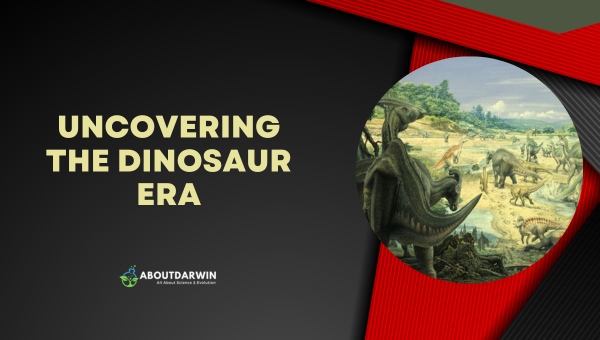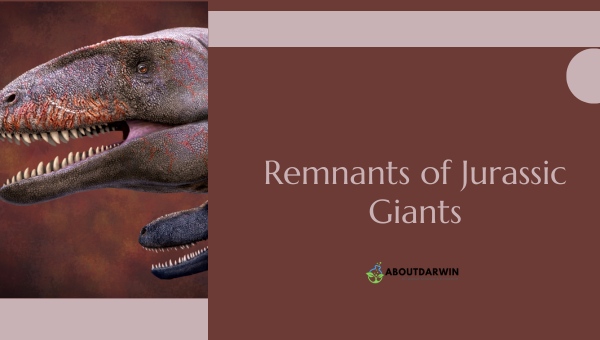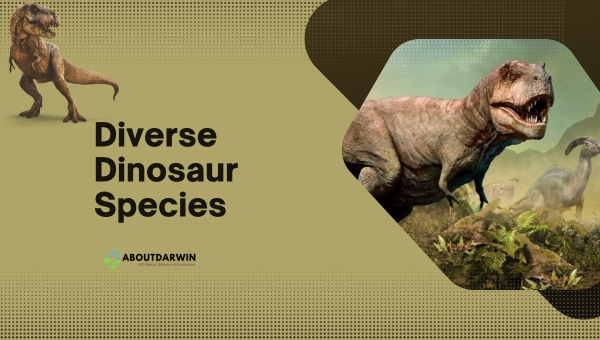Physical Address
304 North Cardinal St.
Dorchester Center, MA 02124
The Dinosaur Era, often called the Mesozoic Era, was an incredible period when dinosaurs dominated the Earth. From around 252 million to about 66 million years ago, this fascinating era was filled with jaw-dropping creatures that roamed and ruled our planet. During this time, Earth underwent drastic changes in climate, sea levels, and landmasses, allowing various species of dinosaurs to thrive and coexist.
My journey through the Dinosaur Era has taught me about the immense diversity of these prehistoric creatures, their unique adaptations, and their impact on the Earth’s geological and biological history. Divided into three distinct periods – the Triassic, Jurassic, and Cretaceous – each epoch experienced its own set of remarkable events and witnessed the emergence and extinction of numerous species of dinosaurs.
Some of the most iconic dinosaurs, such as the enormous long-necked sauropods and the fierce, carnivorous T. rex, inhabited the world during the Dinosaur Era. Fossil discoveries provide fascinating insights into their lives, diets, and environments. Unearthing the secrets of this extraordinary time deepens our understanding of Earth’s history and the remarkable triumphs and trials of the dinosaurs that once ruled our planet.
Contents
Dinosaurs dominated the Earth for millions of years during the Mesozoic Era. Uncovering the details of this period, I’ve found intriguing facts and compelling evidence about these ancient creatures. Let me share with you some of the essential aspects of this fascinating era.

First and foremost, the Mesozoic Era is divided into three periods: Triassic, Jurassic, and Cretaceous. Dinosaurs started appearing during the Triassic Period, around 252 million years ago. These early reptiles were relatively small but evolved into diverse and massive creatures over the next few periods. When the Cretaceous Period arrived, some of the most famous dinosaurs, like the Tyrannosaurus rex and Triceratops, roamed the Earth.
During the Mesozoic Era, the Earth’s continents slowly drifted apart from a single supercontinent called Pangaea. This movement had a significant impact on the climate and in turn, the habitats and adaptations of dinosaurs. It’s believed that different types of dinosaurs occupied specific ecological niches.
The Mesozoic saw an incredible array of plant life as well. Many dinosaur species were herbivores and relied on this diverse vegetation for sustenance. Some common plants during this era included:
As a passionate researcher, I can’t help but be captivated by the immense diversity among dinosaur species and from lumbering sauropods like Apatosaurus to armored ankylosaurs like Ankylosaurus, millions of years of evolution resulted in countless variations of these creatures.
| Period | Start (million years ago) | End (million years ago) | Dominant Dinosaurs |
|---|---|---|---|
| Triassic | 252 | 201 | Early Reptiles |
| Jurassic | 201 | 145 | sauropods, theropods, ornithischians |
| Cretaceous | 145 | 66 | Large carnivores, hadrosaurs, ceratopsians |
Sadly, the dinosaur era ended by a mass extinction event approximately 66 million years ago. Scientists widely accept that a massive asteroid impact played a significant role in this event. This catastrophe annihilated the dinosaurs and caused widespread extinction among other species. However, not all was lost; some descendant species survived and evolved into the birds we know today.
My journey to uncover the secrets of the dinosaur era constantly reveals fascinating insights about these ancient creatures, the world they inhabited, and their enduring legacy in the form of modern birds. The Mesozoic Era and its captivating inhabitants continue to engage the minds of paleontologists, prompting us forever to ponder the mysteries of Earth’s ancient past.
When we think of the Mesozoic Era, also known as the Age of Dinosaurs, we’re transported to a time when colossal creatures roamed the Earth.

The dinosaur era spanned 160 million years, from approximately 252 to 66 million years ago. In this section, I’ll discuss the remnants of these Jurassic giants and their incredible legacy.
The Mesozoic Era is divided into three geological periods:
Dinosaurs dominated the land during these periods, evolving into an impressive array of shapes and sizes. They ranged from the small, feathered Velociraptor to the massive long-necked Brachiosaurus. Fossils paint a vivid picture of the incredible biodiversity that existed among dinosaurs.
Key Dinosaur Finds:
Fossil discoveries are crucial in our understanding of these Jurassic giants. Some key excavation sites include:
Researchers have pieced together a much clearer picture of the dinosaur era through these fossil findings, enabling us to understand their environments and ways of life. Besides fossils, trace fossils – like footprints and nests – also provide valuable information about dinosaur behavior.
Understanding the remnants of Jurassic giants is a fascinating field. The more we learn, the more we appreciate the magnificent creatures that once dominated our planet. With ongoing research and discoveries, we continue to deepen our knowledge of the Mesozoic Era and the dinosaurs that called it home.
Charles Darwin’s Theory of Evolution & Natural Selection
When discussing the dinosaur era, it’s impossible not to be fascinated by the incredible diversity of dinosaur species that once roamed our planet. In this section, I’ll dive into how diverse these prehistoric creatures were and highlight some interesting examples.

Fossil records have shown that there were hundreds of different dinosaur species. Each had unique characteristics and adaptations suited for their habitats and lifestyles. To get a sense of this diversity, let’s consider the three major groups of dinosaurs:
Ornithischians, Also known as “bird-hipped” dinosaurs, these herbivores had a unique hip structure that resembled modern-day birds. Some examples include:
Saurischians: The “lizard-hipped” dinosaurs, which can be further divided into two subgroups – sauropodomorphs (long-necked herbivores) and theropods (mostly carnivorous bipedal dinosaurs). Examples are:
Therizinosaurs: A group of highly specialized, bird-like dinosaurs with peculiar, elongated arms and long, curved claws. They were most likely herbivorous or omnivorous. An example is Therizinosaurus, which had claws up to 3 feet long!
| Group | Example | Characteristics |
|---|---|---|
| Ornithischians | Stegosaurus | Bird-hipped, herbivorous, distinctive plates and a spiked tail |
| Saurischians | Apatosaurus | Lizard-hipped, long-necked herbivores, massive in size |
| Therizinosaurs | Therizinosaurus | Highly specialized, bird-like, elongated arms with long, curved claws |
Size differences among dinosaur species were also incredibly vast. The most miniature known dinosaurs, such as the pigeon-sized Microraptor, weighed only 2 pounds. On the other hand, the heaviest dinosaurs, like the massive Argentinosaurus, could weigh up to 100 tons! This huge variation in size and physiology is part of what makes studying dinosaur diversity endlessly fascinating.
In addition to their biological diversity, the behavior of different dinosaur species also varied significantly. For example, some dinosaurs were solitary predators, while others moved in herds or packs. Social structure, parenting habits, and hunting strategies all differed among the various species.
The dinosaur era was a time of unparalleled diversity in the animal kingdom. With so many unique species, each adapted to different lifestyles and habitats, it’s no wonder that dinosaurs continue to captivate our imaginations today.
The dinosaur era came to an abrupt end around 65 million years ago. Various theories aim to explain the cause of this mysterious mass extinction. In this section, we’ll delve into some of the major theories that researchers have proposed.
One widely accepted theory is the Asteroid Impact Theory. This hypothesis suggests that a massive asteroid collided with Earth, causing fires, tsunamis, and a global “nuclear winter” effect. As a result, most dinosaurs couldn’t adapt to the harsh conditions and perished. The evidence supporting this theory includes:
Another popular hypothesis is the Deccan Traps Volcanism Theory, which implicates volcanic activity as the primary cause of the dinosaurs’ demise. The Deccan Traps are a large volcanic region in present-day India. This theory proposes extensive volcanic eruptions led to drastic climate changes and destroyed the dinosaurs’ habitat. Key evidence backing this idea includes:
Some scientists also propose the Disease Theory as a contributing factor. This theory posits that widespread diseases affecting both plants and animals played a role in the extinction of dinosaurs. However, concrete evidence to support this theory is lacking.
In addition to these hypotheses, the Gradual Climate Change Theory suggests that long-term changes in Earth’s climate contributed to the dinosaurs’ decline. Over millions of years, the planet’s climate went through significant fluctuations, affecting the availability of food and water resources. Consequently, the dinosaurs struggled to adapt and eventually died out.
Overall, several theories attempt to explain the mass extinction of dinosaurs. While some enjoy strong evidence, others lack substantial support. It’s likely that the extinction resulted from a combination of factors, including an asteroid impact, volcanic activity, disease, and climate change.
Dinosaurs were truly remarkable creatures that have contributed significantly to our understanding of the prehistoric world. Let’s explore how these giants shaped the Earth during their time.
First, when we think about dinosaurs, we should recognize that they dominated the Earth for 180 million years. That’s a substantially longer time than the existence of human beings, who have only been around for around 300,000 years. Dinosaurs were diverse in size, shape, and habitat, making them dominant in various ecosystems.
During the Mesozoic Era, dinosaurs played a pivotal role in shaping the Earth’s flora and fauna. Herbivorous dinosaurs, like the long-necked sauropods, consumed massive plant life, stimulating plant evolution, diversification, and adaptation.
Similarly, carnivorous dinosaurs strongly influenced the development of other animal groups as they hunted, providing a competitive spirit in the animal kingdom.
Dinosaurs also had an impact on the climate during their reign. They contributed to the production of greenhouse gases through methane emissions released from herbivores digesting large amounts of plant material.
Consequently, they played a part in maintaining warmer, wetter global climates. To give you a sense of their numbers and impact, here’s a table with a few key statistics:
| Dinosaur Group | Number of Species | Body Size Range |
|---|---|---|
| Sauropods | 150+ | 30ft to over 100ft |
| Ornithopods | 200+ | 3ft to over 40ft |
| Theropods | 330+ | 1ft to over 43ft |
| Thyreophorans | 60+ | 7ft to over 20ft |
As for their impact on the planet’s geology, dinosaurs left abundant fossil evidence that continues to provide valuable scientific knowledge. These fossils are not only limited to bones but also include footprints, eggs, and dung, which further enrich our understanding of their existence.
Finally, dinosaurs were interconnected with their habitat, helping to shape the landscape in various ways. For instance, large herbivores trample and clear vegetation, while predators chase prey, creating distinct pathways through their environments.
From affecting plant and animal evolution to shaping the Earth’s climate and landscapes, dinosaurs have left an undeniable legacy of their influence in the prehistoric world. As we continue to learn from their fossils and traces, we can better understand and appreciate their immense impact on our planet during their time.
The dinosaur era was a fascinating period in Earth’s history, showcasing these prehistoric creatures’ incredible diversity and dominance. Looking back, reflecting on the numerous species that thrived during this time is astounding.
From massive sauropods to ferocious carnivores like the T. rex, dinosaurs ruled the land for millions of years, leaving an indelible mark on our planet’s past.
There were substantial environmental factors at play during their reign. Climate changes and shifting land masses created both opportunities and challenges for dinosaurs. As I mentioned earlier, this dynamic landscape led to the evolution of various species adapting to specific environments, contributing to the rich biodiversity of the era.
It’s important to emphasize the transformative impact of the mass extinction event that marked the end of the dinosaur era. The catastrophic event wiped out around 75% of species on Earth, including most of the dinosaur population. This event paved the way for the rise of mammals and human civilizations.
Here are some key takeaways from our discussion of the dinosaur era:
In the grand scheme of our planet’s history, the dinosaur era is a stark reminder of the incredible adaptability and resilience of life on Earth. It’s fascinating to delve into this unique period, as it offers valuable insights into our planet’s past and the evolutionary processes that have shaped the world in which we live. By studying and understanding the dinosaur era, we can only deepen our appreciation for the intricate tapestry of life around us.